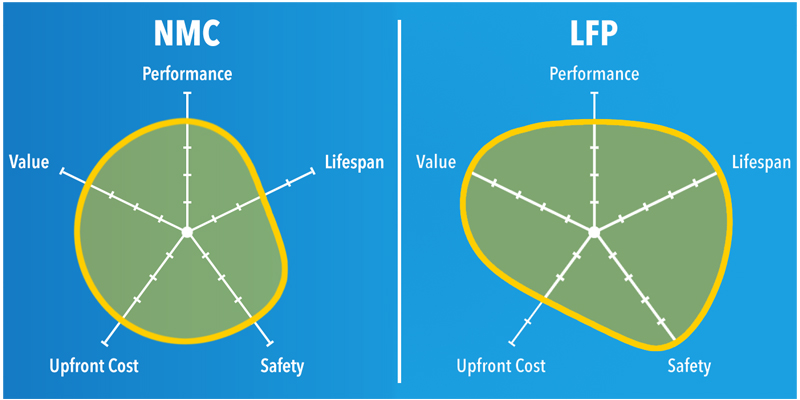LFP vs. NMC Batteries: A Comparison for Nepal’s Road Conditions
LFP vs. NMC Batteries: A Comparison for Nepal’s Road Conditions
When it comes to choosing the right battery for electric vehicles (EVs) in Nepal, the country’s rough terrain, pothole-filled roads, and extreme weather conditions play a big role in determining which type is more suitable. Let’s compare LFP (Lithium Iron Phosphate) and NMC (Nickel Manganese Cobalt) batteries with this context in mind:
| Feature | LFP (Lithium Iron Phosphate) | NMC (Nickel Manganese Cobalt) |
|---|---|---|
| Safety | LFP batteries are more stable and safer in harsh conditions like rough terrains and frequent shocks. They are less prone to overheating or catching fire, making them ideal for Nepal’s bumpy roads and unpredictable paths. | NMC batteries, while generally safe, are more sensitive to extreme conditions and are at a higher risk of overheating in bumpy, rough conditions. This makes them less reliable in Nepal’s challenging driving environments. |
| Durability & Shock Resistance | LFP batteries handle vibrations and shocks from potholes and rough terrain better. They are more resilient to physical stress and can withstand the bumpy roads commonly found across Nepal. | NMC batteries can degrade faster in rugged driving conditions. Repeated vibrations and shocks can reduce their lifespan more quickly compared to LFP. |
| Longevity | LFP batteries offer a longer lifespan, with more charge cycles, making them ideal for frequent commutes on poor-quality roads in Nepal. They last longer, even with constant wear and tear. | NMC batteries have a shorter lifespan in comparison, especially under constant strain. Over time, the frequent use on rough roads could cause faster degradation. |
| Heat Tolerance | LFP batteries are more heat-tolerant, performing well in hot conditions like Nepal’s lowland areas. They handle high temperatures better, ensuring reliability on long drives. | NMC batteries can degrade more quickly in hot climates, which may be a problem in some of Nepal’s hotter regions. They require better cooling systems to maintain performance. |
| Cold Weather Performance | LFP batteries perform reasonably well in colder environments, making them suitable for Nepal’s mountainous regions, where temperatures can drop significantly. | NMC batteries can lose efficiency in extreme cold, which can be a challenge in Nepal’s high-altitude areas. They may not perform as well as LFP in colder regions. |
| Weight | LFP batteries are heavier, but this added weight can actually improve vehicle stability on Nepal’s rough, uneven roads, providing better traction and balance. | NMC batteries are lighter, which is an advantage for efficiency, but on Nepal’s rough terrain, lighter batteries may compromise vehicle stability. |
| Affordability | LFP batteries are generally less expensive, making them more accessible for the budget-conscious market in Nepal, where cost is a key consideration for EV adoption. | NMC batteries are more expensive due to the use of costly materials like nickel and cobalt, making EVs with NMC batteries pricier for Nepalese consumers. |
| Charging Speed | LFP batteries tend to have a slightly slower charging speed, but this is often outweighed by their safety and durability in challenging road conditions. | NMC batteries typically charge faster, which can be an advantage for long-distance travel but may not make a big difference on shorter, rough commutes. |
| Range | LFP batteries offer a shorter range due to their lower energy density. However, for daily urban or short-distance driving on Nepal’s rough roads, this range is usually sufficient. | NMC batteries provide a longer range, which is better suited for long-distance travel. However, in Nepal, where terrain often limits speed and range, this benefit may not be fully utilized. |
Conclusion
For Nepal’s tough road conditions, LFP batteries stand out as the better option. Their safety, durability, and ability to handle harsh terrain make them ideal for the country’s rugged environments. While NMC batteries offer a longer range and lighter weight, their sensitivity to physical stress and higher cost make them less suitable for the frequent bumps, potholes, and extreme weather that drivers face in Nepal.

Please login to comment.